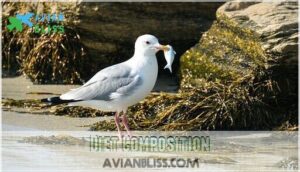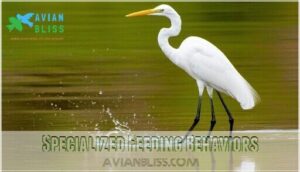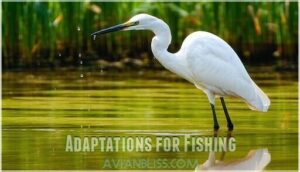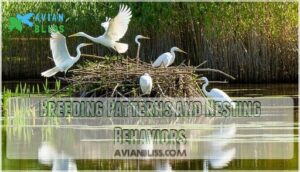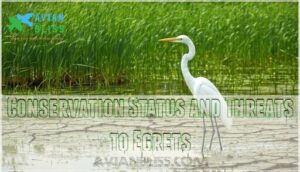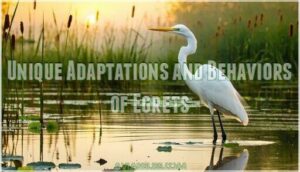This site is supported by our readers. We may earn a commission, at no cost to you, if you purchase through links.
 You’ll spot egrets as those elegant white wading birds patrolling wetlands with stilt-like legs and razor-sharp bills. These skilled hunters use their curved necks to spear fish in lightning-quick strikes while wading through marshes and shallow lakes.
You’ll spot egrets as those elegant white wading birds patrolling wetlands with stilt-like legs and razor-sharp bills. These skilled hunters use their curved necks to spear fish in lightning-quick strikes while wading through marshes and shallow lakes.
Great Egrets show impressive 51-57 inch wingspans and sport yellow bills with black legs during breeding season. They’re adaptable feeders that consume fish, amphibians, and crustaceans using specialized techniques like foot stirring.
Once nearly extinct from plume hunting, egrets now thrive thanks to habitat restoration efforts. Their presence signals healthy wetland ecosystems, and their striking hunting strategies reveal nature’s adaptations.
Table Of Contents
- Key Takeaways
- Egrets: Elegant Waders of North American Wetlands
- Habitat and Distribution of Egrets
- Feeding Habits and Hunting Techniques of Egrets
- Breeding Patterns and Nesting Behaviors
- Egret Migration: Seasonal Movements and Routes
- Conservation Status and Threats to Egrets
- Unique Adaptations and Behaviors of Egrets
- Cultural Significance and Symbolism of Egrets
- Egret Watching: Tips for Birdwatchers
- Role of Egrets in Wetland Ecosystems
- Frequently Asked Questions (FAQs)
- Is an Egret a carnivore?
- What is the spiritual meaning of an egret?
- How long does an egret live?
- What does an egret eat?
- What’s the difference between an egret and a heron?
- What is special about egrets?
- Where do egrets live in the US?
- What is the average lifespan of egrets in the wild?
- How do egrets protect themselves from extreme weather conditions?
- Can egrets be found in urban areas and cities?
- Conclusion
Key Takeaways
- Egrets thrive in wetlands across North America, showing off brilliant white plumage and using sharp bills and S-curved necks to catch fish.
- You’ll recognize different egret species by their size, bill shape, and behaviors—like foot stirring to flush out hidden prey.
- These birds signal healthy wetland ecosystems, and their presence means the landscape’s in good shape.
- Egrets nearly vanished due to plume hunting, but conservation efforts now help them rebound and keep wetlands alive.
Egrets: Elegant Waders of North American Wetlands
Egrets stand out with their striking white plumage and gracefully curved necks as they hunt in shallow waters throughout North America.
These impressive wading birds use their sharp, pointed bills like precision tools to spear fish and small prey in wetlands stretching from Florida’s marshes all the way up to southern Canada.
These elegant birds use their dagger-like bills to catch fish and other prey in wetlands from Florida to southern Canada.
Physical Characteristics
Most egrets sport brilliant white feathers that catch the eye from a distance. You’ll notice their sharp, spear-like bills – perfect tools for nabbing fish and frogs with lightning-quick strikes. Watch how they bend their long necks into graceful S-shapes while hunting, coiled like springs ready to strike.
Those impossibly long legs work like natural stilts, letting them wade through deeper waters where other birds can’t reach. Great Egrets really show off during breeding season, sporting yellow bills and sleek black legs that make their 51-57 inch wingspans even more impressive.
Wingspan variation ranges 51-57 inches in Great Egrets. These egret characteristics include bare part coloration showing yellow bills and black legs during breeding season.
Taxonomy and Classification
If you want to dig into egret taxonomy, you’re looking at the family Ardeidae – that’s where you’ll find herons, bitterns, and our elegant egrets all hanging out together. We’re talking about roughly 65 species scattered across the globe, with most egrets falling into two main camps: the Ardea genus (think your impressive Great Egrets) and Egretta (the smaller, more energetic hunters).
Scientists are still debating some of the finer points about certain populations, which keeps things interesting in the world of bird classification.
Key Classification Facts:
- Family Ardeidae encompasses all heron-like wading birds
- Genus Ardea includes larger species like Great Egrets
- Genus Egretta contains smaller, more active hunters
- Subspecies Debate continues among ornithologists regarding certain populations
Comparison to Herons
You’ll notice Size Differences right away when comparing these birds. Great Blue Herons tower over most Egret Species, while White Herons and Egrets share similar builds.
Neck Posture varies too – herons often keep necks extended, egrets curve theirs more.
Both groups show Habitat Overlap in wetlands and use similar Foraging Styles.
Social Behavior differs slightly, but Bird Identification requires close observation of these subtle distinctions.
Notable Egret Species
North American wetlands showcase four main egret species, each with distinct characteristics. The Great Egret stands tallest with pure white plumage. Cattle Egrets follow livestock across fields. Snowy Egrets display delicate features and yellow feet. Reddish Egrets perform their signature fishing dance in shallow waters.
- Great Egret – Largest species with distinctive S-curved neck
- Cattle Egret – Often found near grazing animals in open fields
- Snowy Egret – Smaller white egret with bright yellow feet
- Reddish Egret – Known for energetic hunting displays and reddish plumage
Habitat and Distribution of Egrets
North America’s waterways are home to egrets that have carved out niches in diverse wetland habitats spanning an impressive geographic range. These wading birds depend heavily on wetland environments, making themselves at home in marshes, swamps, coastal estuaries, and shallow lakes stretching from Florida all the way up to southern Canada.
Great Egrets have been particularly successful at expanding their range, pushing into northern areas they hadn’t occupied before thanks to shifting climate patterns and ongoing habitat restoration efforts. When it comes to nesting, these birds typically choose wooded swamps and protected islands where specific habitat requirements create ideal breeding conditions.
Snowy and Reddish Egrets tend to stick to southeastern wetland areas, while Cattle Egrets have proven more flexible in their habitat choices. What makes egrets so successful is their ability to use both freshwater and saltwater environments, establishing them as versatile wetland specialists well-suited to North America’s ever-changing landscape. You’ll often spot them in areas with slow-moving water, which makes hunting much easier for these patient predators.
Colony locations usually occur in wooded swamps and protected islands, where habitat specificity ensures choice nesting conditions. Snowy and Reddish Egrets prefer southeastern wetland habitats, while Cattle Egrets adapt to varied environments. Their preferred habitat includes both freshwater and saltwater systems, making them adaptable wetland specialists perfectly adapted for North America’s changing landscapes. They’re often seen in areas with slow-moving water, which aids their feeding habits.
Feeding Habits and Hunting Techniques of Egrets
These skilled hunters rely on sharp bills and long necks to spear fish in lightning-quick strikes.
Their hunting tactics range from patient stalking through shallow waters to actively pursuing prey across wetland territories.
These wading birds employ several hunting methods, from patient stalking in shallow water to active pursuit of prey through wetland habitats.
Diet Composition
Egrets eat whatever’s available in their wetland habitats. Fish form their primary diet, but these wading birds aren’t picky about prey selection. Their feeding behavior shows considerable dietary overlap with other wetland species.
These adaptable foraging locations meet their nutritional needs year-round.
- Fish: Main course ranging from small minnows to larger catches
- Amphibians: Frogs and salamanders provide protein-rich meals
- Crustaceans and insects: Seasonal variation brings aquatic invertebrates
Specialized Feeding Behaviors
Wading birds have mastered some pretty clever hunting tricks that go way beyond just standing around waiting for fish to swim by. Take foot stirring – they’ll shuffle their feet in the mud and sand to kick up clouds of sediment, which startles small fish and crustaceans right out of their hiding spots.
Then there’s bill vibrating, where they use their beaks like underwater metal detectors, picking up the tiniest tremors that give away a fish’s location.
Some species even team up for group hunts, working together like underwater sheepdogs to herd schools of fish into tighter spaces where they’re easier to catch.
Some species practice cooperative feeding, working together to corral schools of fish.
Prey specificity varies by habitat, with different feeding behavior patterns emerging in wetlands birds based on water depth and available food sources.
Adaptations for Fishing
Egrets have evolved into incredible fishing machines through some pretty amazing body modifications. That flexible, S-shaped neck works like a coiled spring, snapping forward with lightning speed when a fish swims within range.
Egrets have evolved flexible, S-shaped necks that work like coiled springs, snapping forward with lightning speed when fish swim within range
Their bills aren’t just sharp – they’re perfectly engineered daggers that can pierce through water and grip even the most slippery prey.
Those impossibly long legs aren’t just for show either; they let egrets wade into deeper waters while spreading their weight across soft mud so they don’t sink.
But perhaps most impressive is their razor-sharp eyesight, which can spot the slightest movement beneath the surface from their towering vantage point.
Key fishing adaptations include:
- S-curved necks that compress like springs for rapid strikes
- Dagger-shaped bills designed for piercing and gripping slippery fish
- Long legs that distribute weight evenly across muddy substrates
- Specialized Postures Behavior including motionless stalking in Wetlands Birds Habitat
Breeding Patterns and Nesting Behaviors
You’ll observe egrets beginning their breeding cycle around age 2-3 years, with males selecting nest sites and performing elaborate courtship displays that include circular flights and neck stretching.
These colonial nesters construct stick platforms 10-40 feet above water, with both sexes building the nest before the female lays 4-5 eggs that incubate for 23-24 days.
Courtship Rituals
Breeding season turns male egrets into showoffs. They’ll call out loudly, trace circles through the sky, and stretch their necks like they’re trying to touch the clouds. These guys know exactly what they’re doing – picking the perfect spot in the colony before putting on their whole song-and-dance routine.
The fancy feather displays are all about catching a female’s eye and sealing the deal for another successful nesting season.
Males carefully choose their nest selection sites within the colony, then engage in elaborate postures behavior showcasing their plumage patterns.
This bird breeding process strengthens pair bonding while maintaining colony dynamics essential for successful nesting behavior.
Nest Construction
After courtship ends, the pair gets down to business building their home. They’re impressive builders, crafting sturdy platform nests from sticks and twigs that sit anywhere from 10 to 40 feet up in waterside trees.
What’s really striking is how they cluster together—you’ll find hundreds of pairs cramming into the best spots, turning prime nesting areas into bustling neighborhoods.
- Nest materials: Sticks, twigs, and reeds woven into sturdy platforms
- Construction timeline: Takes 2-3 days of focused building effort
- Parental roles: Both sexes contribute equally to nest construction duties
Egg Laying and Incubation
Once your nest is ready, the female lays her clutch of pale blue-green eggs. Most egrets produce 4-5 eggs during the breeding season. Both parents share parental care duties during the 23-24 day incubation period.
Here’s what happens during this critical stage:
- Egg composition: Calcium-rich shells protect developing embryos
- Clutch size: Usually 4-5 eggs laid over several days
- Incubation period: Parents alternate sitting duties every 2-4 hours
- Nesting success: Depends on weather and predator protection
- Young development: Embryos grow rapidly in a controlled temperature environment
Chick Rearing
After eggs hatch, parental care kicks into high gear. Both parents deliver a feeding frequency of every 20-30 minutes during the breeding season.
Young grow rapidly on regurgitated fish and insects. Chick development shows dramatic size increases within weeks. Sibling competition affects fledgling success rates.
Post-fledging dependency lasts several weeks as parents continue teaching feeding habits and bird diet preferences.
Egret Migration: Seasonal Movements and Routes
Throughout spring and fall, you’ll witness striking Bird Migration patterns as Great Egrets and Snowy Egrets travel North America’s major Flyway Routes. These birds move southward for winter to Central America and the Caribbean, while northern breeding populations migrate south. They migrate by day in small flocks. Egrets undertake these journeys to boost food availability.
- Migration Triggers: Temperature changes, daylight hours, and food availability signal departure times
- Primary Navigation Methods: Coastal routes and river valleys guide their aerial highways
- Stopover Ecology: Wetland Habitats provide vital refueling stations during long journeys
- Climate Impacts: Mild winters allow some populations to remain further north than usual
- Range Flexibility: Individual egrets may adjust their migration distance based on local conditions
Conservation Status and Threats to Egrets
Egret populations still struggle today, even after bouncing back from the brink during the plume hunting days.
Habitat loss from wetland destruction remains the biggest problem, along with climate change messing with their breeding and feeding spots.
Today’s main threats include habitat loss from wetland destruction and climate change impacts on their breeding and feeding grounds.
Historical Hunting for Plumes
Hunting egrets for their ornate breeding plumes nearly drove these species to extinction during the late 1800s and early 1900s. The fashion industry’s demand for white herons and egrets feathers created a lucrative plume trade that devastated bird populations across North America.
| Period | Impact on Egret Population Decline | Conservation Response |
|---|---|---|
| 1880-1900 | Severe hunting pressure for fashion | Early Audubon advocacy begins |
| 1900-1918 | Near extinction of multiple species | Migratory Bird Treaty Act passed |
| 1918-1940 | Federal laws enforcement begins | Population recovery starts |
| 1940-1970 | Habitat protection expands | Conservation law origins solidify |
| 1970-Present | Stable populations maintained | Modern bird conservation continues |
Federal laws ended this ethical hunting debate, transforming egret habitat protection and establishing the foundation for today’s Audubon field guide success stories.
Habitat Loss and Degradation
Wetland Conversion threatens egret populations across North America. You’ll find their Habitat disappearing as developers drain marshes for agriculture and urban sprawl.
Pollution Impacts from runoff contaminate water sources, reducing fish populations egrets depend on. Climate Change alters precipitation patterns, affecting water levels in breeding areas. Habitat Fragmentation isolates colonies, making reproduction difficult.
Federal Laws now back Habitat Preservation and Bird Conservation through Restoration Efforts.
Current Conservation Efforts
Conservation teams are doing more than just keeping tabs on bird populations these days. They’ve developed comprehensive management plans for key breeding and feeding sites, and the results show – Great Egret numbers are climbing by about 1.5% each year across North America. Federal protections help shield these birds from harm, while habitat restoration efforts are bringing wetlands back to life from Florida all the way north.
The work breaks down into three main areas: tracking egret populations and how well they’re breeding, keeping predators in check and minimizing human interference, and running education programs that help local communities understand why protecting North American birds matters.
- Population Monitoring tracks egret numbers and breeding success rates
- Threat Mitigation controls predators and limits human disturbance
- Public Awareness campaigns educate communities about North American Birds conservation
Unique Adaptations and Behaviors of Egrets
Egrets are skilled hunters that deploy striking hunting tools while living in complex social structures within wetland colonies.
These members of the Ardeidae family showcase fascinating interspecies relationships and have evolved specialized feeding adaptations that distinguish them from their wading bird cousins.
These Ardeidae family members demonstrate interspecies relationships and specialized feeding adaptations that set them apart from other wading birds.
Tool Use in Hunting
You’ll be amazed by egrets’ clever hunting strategies. These water birds use intricate bait fishing techniques, dropping insects or bread pieces to attract fish. Some species employ feather use, plucking their own plumes as lures. Plant use involves breaking off twigs for probing muddy bottoms. Cooperative hunting occurs when multiple egrets work together, creating disturbances to flush prey. This learned behavior develops through observation and practice.
| Tool Type | Purpose |
|---|---|
| Insects/bread | Fish attraction bait |
| Feathers | Floating lures |
| Sticks/twigs | Bottom probing tools |
| Group coordination | Prey flushing strategy |
These typical behaviors vary across habitat types. In shallow marshes, egrets adopt specific postures behavior while handling tools. Unlike other heron species, egrets show striking innovation in their hunting methods, making them singular among North American water birds.
Social Behaviors in Colonies
Beyond hunting techniques, white herons and egrets display fascinating social behaviors in their breeding colonies. These water birds create complex communities with distinct colony hierarchy systems. You’ll observe cooperative defense strategies where adults work together to protect nesting areas from predators. Nesting synchrony helps guarantee chick survival, as most pairs breed simultaneously. Parents use chick recognition abilities to identify their own offspring among hundreds of similar-looking young.
Here’s what makes their typical behaviors so striking:
- Information sharing occurs through specific postures behavior and vocalizations
- Territorial disputes involve ritualized displays rather than physical combat
- Communal roosting provides safety in numbers during non-breeding seasons
- Feeding coordination prevents overcrowding at prime fishing spots
- Collective mobbing drives away threats through coordinated group responses
These heron species demonstrate that survival often depends on community cooperation rather than individual prowess.
Interspecies Relationships
Several fascinating Symbiotic Relationships define egrets’ interactions across North America. Cattle egrets demonstrate commensalism with grazing mammals, following livestock to catch insects stirred by movement. These Colonial Nesting birds also form warning systems with buffalo.
Competition Dynamics emerge when multiple species share habitat resources, creating complex Ecosystem Impact patterns throughout their range.
| Relationship Type | Partner Species | Benefit |
|---|---|---|
| Commensalism | Cattle/Buffalo | Insect foraging |
| Competition | Herons | Shared hunting grounds |
| Mutualism | Large mammals | Pest removal service |
| Warning system | Grazing animals | Predator alerts |
| Nesting association | Mixed colonies | Safety in numbers |
Cultural Significance and Symbolism of Egrets
You’ll find that egrets appear in art and folklore across many cultures as symbols of purity and grace.
These elegant wading birds represent patience and focus in traditional beliefs from Asia to the Americas.
Egrets in Art and Literature
Literature and fine art showcase egrets as symbols of grace and purity. Artists have captured their elegant forms for centuries. The Great Egret became the symbol of the National Audubon Society after conservation efforts protected their colonies from feathered fashion demands. Great and Snowy Egrets were poached for their nuptial plumes, which were worth more than their weight in gold by the late 19th century. Their artistic depictions range from detailed scientific illustrations to flowing poetry celebrating their ethereal beauty.
Here’s how egrets inspire creative expression:
- Asian watercolor traditions – Japanese artists featured egrets in delicate brush paintings, emphasizing their graceful color pattern against natural backgrounds
- Scientific illustrations – Audubon’s watercolors captured Great Egret and Snowy Egret details with precise anatomical accuracy for field identification
- Conservation narratives – Literature transformed from celebrating feathered fashion to promoting White Herons and Egrets protection through compelling stories
- Modern poetry – Contemporary writers use literary egret imagery to represent environmental resilience and natural beauty in their verse
Egret symbolism continues influencing artists worldwide today.
Traditional Beliefs and Folklore
White herons and egrets have long captivated cultures worldwide through their graceful presence. Native Americans revered these birds as symbols of peace, abundance, and good fortune, particularly linking them to successful fishing. Cherokee diplomats wore egret feathers as peace emblems, while these elegant birds served as mediators in tribal legends.
Among the Iroquois, spotting an egret signals good hunting omens, and folklore suggests shamans reincarnate as these patient creatures. Their symbolism extends beyond North America, representing purity and spiritual guidance across cultures. These mythological creatures continue inspiring traditions today.
Culture Egret Symbolism Folklore Origins
Egret Watching: Tips for Birdwatchers
The best spots for watching egrets are shallow wetlands, marshes, and pond edges, especially during early morning or late afternoon.
Look for their distinctive S-curved necks and dagger-like bills as they wade slowly through the water hunting fish.
Watch for their distinctive S-curved necks and dagger-like bills as they wade slowly through water hunting fish.
Best Locations for Egret Sightings
After exploring egrets’ cultural importance, let’s find where you can actually see these stunning birds. Prime Egret Habitats across North America offer excellent viewing opportunities throughout the year. Here are four top locations for spotting these graceful waders:
- Coastal Viewing areas: Saltwater marshes and estuaries provide shallow waters where egrets hunt fish
- Inland Sanctuaries: Freshwater wetlands in the United States and southern Canada maintain year-round populations
- Seasonal Hotspots: Florida’s Range extends through breeding colonies during spring and summer months
- Migration Routes: Watch for traveling flocks along established flyways during fall and spring movements
Identifying Different Egret Species
You’ll spot differences quickly when you know what to look for. Great Egret stands tallest with a yellow bill morphology and black legs. Snowy Egret shows bright yellow feet with a black bill and legs. Cattle Egret appears stockiest with orange-buff plumage variations during breeding.
Check size comparison – Great Egrets tower over Snowy Egrets. Note habitat preference and listen for distinct vocalizations to confirm white egrets identification through color pattern details.
Photography Tips for Egret Enthusiasts
Once you’ve identified egret species, capturing their beauty requires proper technique. Use fast shutter speeds for Action Shots during hunting behavior. Lighting Conditions matter—shoot during golden hour for warm tones against White Herons and Egrets‘ plumage.
Apply Composition Techniques like rule of thirds, framing birds in their Habitat. Choose telephoto lenses for Equipment Choices to maintain distance.
Document various Postures Behavior and Color Pattern details. Practice Ethical Considerations by never disturbing nesting sites during Bird Watching sessions.
Role of Egrets in Wetland Ecosystems
Egrets act as living barometers for wetland ecosystems, signaling environmental health through their presence and behavior. Their skilled hunting keeps fish populations in check, while their daily travels create a natural nutrient highway—moving essential elements from water to land through their droppings and feeding patterns.
These elegant waders also contribute to nutrient cycling by transferring nutrients from aquatic systems to terrestrial areas through their waste and movement patterns.
Indicator Species for Environmental Health
Wetland-dependent egrets function as living thermometers for ecosystem health. When Great Egret and Snowy Egret populations decline, scientists detect mercury contamination and habitat degradation early.
These bioindicators reveal wetland health through their population trends and bare parts coloration. Healthy habitat quality bolsters stable egret colonies, while polluted waters show reduced breeding success and range shifts.
Impact on Fish Populations
Egrets greatly influence Fish Stock Dynamics through selective predation. Great Egrets and Snowy Egrets create Prey Selection Pressures by targeting specific fish sizes and species within their range.
This hunting behavior generates Ecosystem Cascade Effects that ripple through wetland food webs. Their feeding Postures Behavior affects local fish communities, while Aquaculture Interactions can impact managed fish populations, creating important Fisheries Management Implications for conservation planning.
Contributions to Nutrient Cycling
Through multiple wetland systems across their range, White Herons and Egrets act as nutrient delivery systems. Their guano enrichment creates hotspots of nitrogen and phosphorus.
Three key contributions maintain ecosystem balance:
- Waste decomposition: Snowy Egret and Cattle Egret droppings fertilize surrounding soils, supporting plant growth.
- Nutrient transport: Their feeding postures behavior transfers nutrients from water to land.
- Soil aeration: Colony movement patterns distribute essential minerals across wetland zones.
Frequently Asked Questions (FAQs)
Is an Egret a carnivore?
You might think they’re just pretty wading birds, but yes, you’re looking at true carnivores. These elegant hunters exclusively eat fish, frogs, crustaceans, and small animals—no plants whatsoever.
What is the spiritual meaning of an egret?
Spot an egret and you’re glimpsing the symbolism of patience, resilience, and self-reliance. You might see it as a nudge to stand tall, move with purpose, and keep your balance—no matter life’s shifting tides.
How long does an egret live?
Imagine clocking decades in the wild—some individuals reach 15 or more years. You’ll notice field researchers refer to “lifespan” as variable, influenced by predation, environmental pressures, and habitat stability within Egret populations.
What does an egret eat?
You’ll watch as this bird stalks fish, frogs, and snakes in shallow water. Sometimes it grabs insects or small mammals in fields. Egrets use their long bills to catch anything wriggling or swimming close by.
What’s the difference between an egret and a heron?
You’ll think egrets and herons are twins, but look closer—egrets usually flaunt all-white plumage and slim, yellow bills, while herons show off grayish feathers and heftier frames. Egrets tend to be daintier dancers.
What is special about egrets?
You’ll notice these tall wading birds by their striking white plumage and graceful, S-curved necks. They hunt fish with quick jabs from their sharp bills and gather in colonies, making wetlands come alive.
Where do egrets live in the US?
You’ll spot these long-legged waders in wetlands, marshes, and along the coasts across the U.S.
From Florida bayous to California estuaries, egrets range wide—anywhere shallow water invites patient hunting and colony nesting.
What is the average lifespan of egrets in the wild?
Like a river winding through time, these birds usually live 10-15 years in the wild.
With sturdy legs and keen eyesight, they dodge predators and harsh seasons, showing you survival isn’t just for the bold.
How do egrets protect themselves from extreme weather conditions?
When storms hit, you’ll notice egrets use dense reeds or trees as windbreaks. Their waterproof feathers shield against rain. By flocking together, they find strength in numbers, hunkering down until the skies clear.
Can egrets be found in urban areas and cities?
Think of a city as a patchwork of microhabitats. You’ll occasionally see these wading birds in urban parks, ponds, or golf courses, especially if there’s water and food nearby. Egrets adapt remarkably to human-altered spaces.
Conclusion
Like silent poets, egrets glide across wetlands, shaping the landscape’s rhythm. You’ll spot their white forms as clear signals of healthy habitats. Their precise hunting shows nature’s engineering at work.
If you watch closely, you’ll see how these birds adapt to shifting ecosystems. Egrets play critical roles—controlling fish populations and signaling ecological changes.
By learning about egrets, you understand both their world and your own connection to thriving wetlands and natural balance.

